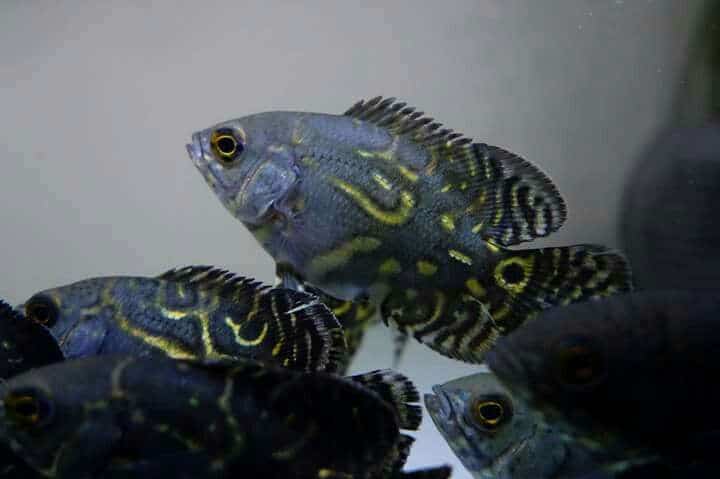Oscar fish, a member of the cichlid family, are colorful freshwater fish renowned for their personality and intelligence. Originally hailing from the Amazon River basin in South America, these vibrant creatures have captivated the hearts of aquarists worldwide. While they are often found in an array of colors due to selective breeding, wild Oscar fish typically showcase a more subdued coloration, often reflecting the environment they come from.
In their natural habitat, Oscars require plenty of space to roam and explore. They grow to an impressive size and possess a bold demeanor, making them one of the more captivating species to observe. Their diet in the wild consists primarily of smaller fish, crustaceans, and insects, but in captivity, they have proven to be quite adaptive, accepting a variety of prepared foods. Understanding the feeding rituals and territorial behaviors of Oscars is crucial for anyone looking to maintain a healthy environment for these fish.
Key Takeaways
- Oscar fish are a type of cichlid originally from the Amazon River basin known for their intelligence.
- They have specific dietary and territorial requirements that are vital for their wellbeing.
- Proper aquarium care, including ample space and water conditions, is essential for Oscar health.
Natural Habitat and Origin
In this section, we’ll explore where the Oscar fish originally comes from and the natural environments it thrives in.
Geographic Distribution
The Oscar fish, scientifically known as Astronotus ocellatus, is indigenous to South America, predominantly found in the Amazon River Basin. Our investigations reveal their presence across various countries including Brazil, Peru, Colombia, and Venezuela. Although not native to North America, Oscars have been introduced to regions like Florida through aquarium releases.
Environmental Conditions
Oscars thrive in a freshwater habitat characterized by slow-moving water, such as the calm sections of rivers and streams. Their natural environment includes plenty of vegetation, which is essential for providing cover and supporting a healthy ecosystem. The water conditions they prefer typically exhibit a warm temperature and a slightly acidic to neutral pH. Further south in the continent, Oscars can also be found in the waterways of Paraguay, Argentina, and Uruguay, reinforcing their adaptability to a range of subtropical climates.
Physical Characteristics and Varieties
We will now examine the physical attributes and the different color patterns that distinguish the Oscar fish, a popular member of the cichlid family renowned for its interactive behavior and intelligence.
Typical Appearance
The Oscar fish (Astronotus ocellatus) boasts a robust and laterally compressed body, typically showcasing an oval shape. Adult Oscars can grow quite large, generally reaching sizes up to 12-14 inches (30-35 cm) in captivity, with wild specimens growing even larger. They possess sizable dorsal and anal fins, with their dorsal fin running along the length of the back and containing spiny rays at the front. The caudal fin is fan-shaped, aiding in quick and agile movement. Oscars feature prominent ocelli, which are eye-like spots often used to dissuade predators, giving them a unique appearance among their aquatic counterparts.
Color Variations
Oscars exhibit a variety of colors and patterns, showing a remarkable degree of polymorphism. Common varieties include the Tiger Oscar with a combination of orange-red and black markings, and the Red Oscar, which presents a more solid red coloration. The Albino Oscar is a striking variety due to the lack of pigment, resulting in a white body with red eyes. Blue Oscars display a subtle bluish hue, adding to the diversity of this species.
A table encapsulating the common Oscar fish varieties:
| Variety | Primary Body Color | Markings/Features |
|---|---|---|
| Tiger Oscar | Dark base | Orange-red pattern |
| Red Oscar | Red | Minimal black markings |
| Albino Oscar | White | Red eyes, may have faint markings |
| Blue Oscar | Blue-grey | Diffuse bluish tinge |
Other notable varieties include the Velvet Cichlid, bearing a dark, velvety complexion, and the Marble Cichlid, with a marbled blend of black, white, and orange tones. Rarely seen, the Lemon Oscar displays a bright yellow undertone with muted black markings. Regardless of the variety, we must nurture these fish in well-maintained environments to ensure their colors remain vivid and health optimal.
Diet and Feeding Habits

Oscar fish have a varied diet that showcases their omnivorous nature. We must provide a balance of nutrients to ensure their health and vitality.
Common Foods
Oscars thrive on a diet that includes both animal and plant-based items. Here are specific examples of foods they commonly consume:
- Insects & Larvae: Such as crickets and bloodworms.
- Worms: Earthworms are a nutritious live food option.
- Plant Matter: They will occasionally eat bits of vegetables.
- Commercial Foods: Pellets or sticks specifically formulated for carnivorous fish.
- Frozen Food: This can include brine shrimp or beef heart; however, offering frozen food should be done sparingly to avoid fatty liver disease.
Incorporating vitamin C into their diet is essential for preventing diseases. Some commercial foods are fortified with vitamin C, which is crucial for the osca’rs immune health.
Feeding Behaviors
Oscar fish display intriguing behaviors when feeding:
- Appetite: Oscars have hearty appetites and are known for their eagerness during feeding times.
- Live Foods: They enjoy chasing and capturing live foods, thus live feedings can also serve as mental stimulation and exercise.
We must monitor their feeding to prevent overfeeding, which Oscars are prone to given their robust appetites. It’s recommended to feed Oscars small portions that they can consume within a couple of minutes, 1-2 times daily.
Behavior and Territoriality

Oscar fish exhibit distinctive behavioral patterns, especially regarding territoriality and social dynamics. We will be examining their interactions among their species and their breeding behaviors to gain insights into their nature as territorial cichlids.
Social Interactions
In the realm of social behavior, Oscars are known to be highly territorial, especially towards members of their own species. In an aquarium, we observe that each Oscar establishes its territory, which it vigorously defends against intruders. Adverse reactions are most pronounced towards unfamiliar Oscars, whereas established tank mates are sometimes tolerated, given a well-structured environment with ample hiding spots.
- Territorial Markers: Oscars often use physical landmarks in their environment like rocks, or driftwood to define their space.
- Aggression: This species can become aggressive when defending territory, often engaging in chasing and displaying threatening body postures.
Breeding Patterns
During the breeding season, Oscars exhibit specific behaviors that include establishing a breeding territory. This territory becomes the focal point for their mating rituals and subsequent laying and fertilization of eggs.
- Formation of Breeding Pairs: Oscars typically form monogamous pairs for the breeding season.
- Spawning Sites: Suitable flat surfaces are meticulously cleaned by the breeding pair, preparing for the female to lay eggs.
- Parental Care: After the female has spawned and the male has fertilized the eggs, both parents are actively involved in the care of the fry, defending them against predators.
The breeding territory not only serves as a nursery but is also zealously defended by the parent Oscars, who are known to be remarkably attentive and protective of their young. During this period, Oscars can display heightened levels of aggression, which ensures the survival of the next generation in their natural habitat, where numerous predators are present.
Aquarium Care
Maintaining a healthy environment for Oscar Fish in a home aquarium is crucial for their longevity and well-being. Below we’ll specify the tank necessities and discuss health concerns along with disease prevention for these vibrant members of the cichlid family.
Tank Requirements
An Oscar Fish requires a large tank to thrive, with a recommended minimum size of 75 gallons for a single Oscar. For each additional Oscar, it’s ideal to add another 30-50 gallons to ensure adequate space, as they are quite active and can grow quite large.
- Water Parameters:
- Temperature: 74-81°F (23-27°C)
- pH: 6.5-7.5
- Hardness: 5-20 dH
Provide a powerful filtration system with efficient suction to accommodate the Oscar’s heavy bioload. A sandy substrate is preferred, mimicking their natural habitat and allowing them to dig without harming themselves. It is important to include:
- Lighting: Standard aquarium lighting is sufficient.
- Decorations: Rocks and driftwood for hiding spaces; however, plants may be uprooted due to their digging behavior.
A spacious environment with appropriate water parameters and decor will facilitate the best Oscar fish care practices and minimize aggression often seen in cramped conditions.
Health and Diseases
Oscar Fish are susceptible to common aquarium fish diseases, particularly when stress is a factor in a poorly maintained tank. Two of the most prevalent issues are:
- Fin rot: Caused by bacteria, evidenced by fraying or disintegrating fins.
- Hole-in-the-head disease: Often linked to dietary deficiencies or poor water quality.
Regular monitoring for signs of stress or illness is essential. A quarantine tank for new tank mates can prevent the spread of diseases. Consistent water changes, balanced nutrition, and careful selection of tank mates are integral to preventing health problems and ensuring the cost associated with pet care does not escalate due to preventable diseases.
Frequently Asked Questions
In this section, we’ll address some common inquiries about Oscar fish and provide insight into their behaviors, needs, and characteristics.
What is the natural habitat of Oscar fish?
Oscar fish are native to South America, thriving in slow-moving rivers, lakes, and floodplains of the Amazon Basin. They prefer warm, acidic water with plenty of hiding spots.
What are common tank mates for Oscar fish in captivity?
While Oscars can be aggressive, suitable tank mates may include larger fish that are not easily bullied, such as Silver Dollars, larger catfish species, and some cichlids. Always monitor interactions to ensure compatibility.
How long do Oscar fish typically live?
In a well-maintained aquarium, Oscar fish have a lifespan of 10 to 15 years, provided they receive proper care, diet, and water quality.
What diet do wild Oscar fish have?
Wild Oscar fish are omnivores, eating a variety of foods such as insects, crustaceans, and plant matter. In captivity, they require a similar diet to stay healthy.
Are Oscar fish considered invasive in certain environments?
Yes, Oscar fish are invasive in regions outside their native habitats, such as Florida, USA. They can disrupt local ecosystems by preying on native species and competing for resources.
What is the maximum size that Oscar fish can reach?
Oscar fish can grow quite large, generally reaching up to 12 to 14 inches (30 to 36 centimeters) in length in an aquarium setting. Some may grow even larger under optimal conditions.






